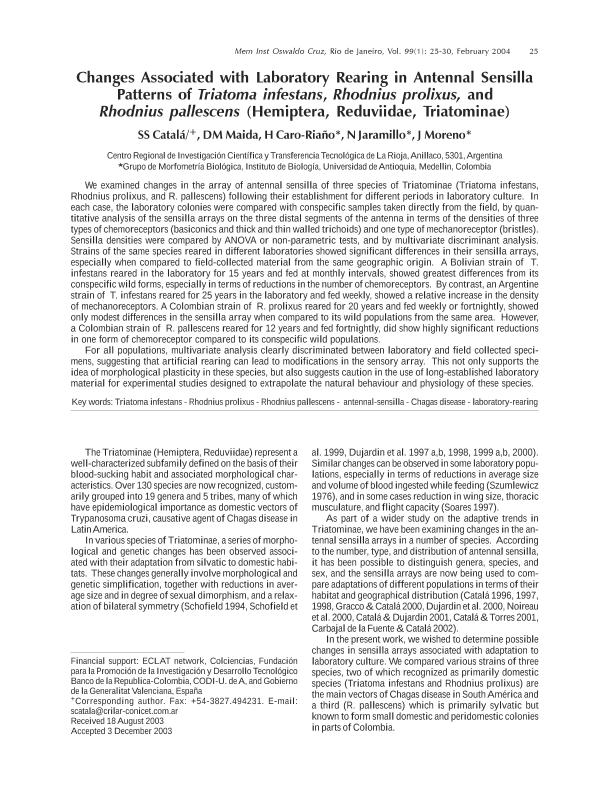Artículo
Changes associated with laboratory rearing in antennal sensilla patterns of Triatoma infestans, Rhodnius prolixus, and Rhodnius pallescens (Hemiptera, Reduviidae, Triatominae)
Fecha de publicación:
12/2004
Editorial:
Fundação Oswaldo Cruz
Revista:
Memórias do Instituto Oswaldo Cruz
ISSN:
0074-0276
e-ISSN:
1678-8060
Idioma:
Inglés
Tipo de recurso:
Artículo publicado
Clasificación temática:
Resumen
We examined changes in the array of antennal sensilla of three species of Triatominae (Triatoma infestans, Rhodnius prolixus, and R. pallescens) following their establishment for different periods in laboratory culture. In each case, the laboratory colonies were compared with conspecific samples taken directly from the field, by quantitative analysis of the sensilla arrays on the three distal segments of the antenna in terms of the densities of three types of chemoreceptors (basiconics and thick and thin walled trichoids) and one type of mechanoreceptor (bristles). Sensilla densities were compared by ANOVA or non-parametric tests, and by multivariate discriminant analysis. Strains of the same species reared in different laboratories showed significant differences in their sensilla arrays, especially when compared to field-collected material from the same geographic origin. A Bolivian strain of T. infestans reared in the laboratory for 15 years and fed at monthly intervals, showed greatest differences from its conspecific wild forms, especially in terms of reductions in the number of chemoreceptors. By contrast, an Argentine strain of T. infestans reared for 25 years in the laboratory and fed weekly, showed a relative increase in the density of mechanoreceptors. A Colombian strain of R. prolixus reared for 20 years and fed weekly or fortnightly, showed only modest differences in the sensilla array when compared to its wild populations from the same area. However, a Colombian strain of R. pallescens reared for 12 years and fed fortnightly, did show highly significant reductions in one form of chemoreceptor compared to its conspecific wild populations. For all populations, multivariate analysis clearly discriminated between laboratory and field collected specimens, suggesting that artificial rearing can lead to modifications in the sensory array. This not only supports the idea of morphological plasticity in these species, but also suggests caution in the use of long-established laboratory material for experimental studies designed to extrapolate the natural behaviour and physiology of these species.
Archivos asociados
Licencia
Identificadores
Colecciones
Articulos(CRILAR)
Articulos de CENTRO REGIONAL DE INV. CIENTIFICAS Y TRANSFERENCIA TECNOLOGICA DE ANILLACO
Articulos de CENTRO REGIONAL DE INV. CIENTIFICAS Y TRANSFERENCIA TECNOLOGICA DE ANILLACO
Citación
Catala, Silvia Susana; Maida, D. M.; Caro Riaño, H.; Jaramillo, N.; Moreno, J.; Changes associated with laboratory rearing in antennal sensilla patterns of Triatoma infestans, Rhodnius prolixus, and Rhodnius pallescens (Hemiptera, Reduviidae, Triatominae); Fundação Oswaldo Cruz; Memórias do Instituto Oswaldo Cruz; 99; 1; 12-2004; 25-30
Compartir
Altmétricas




